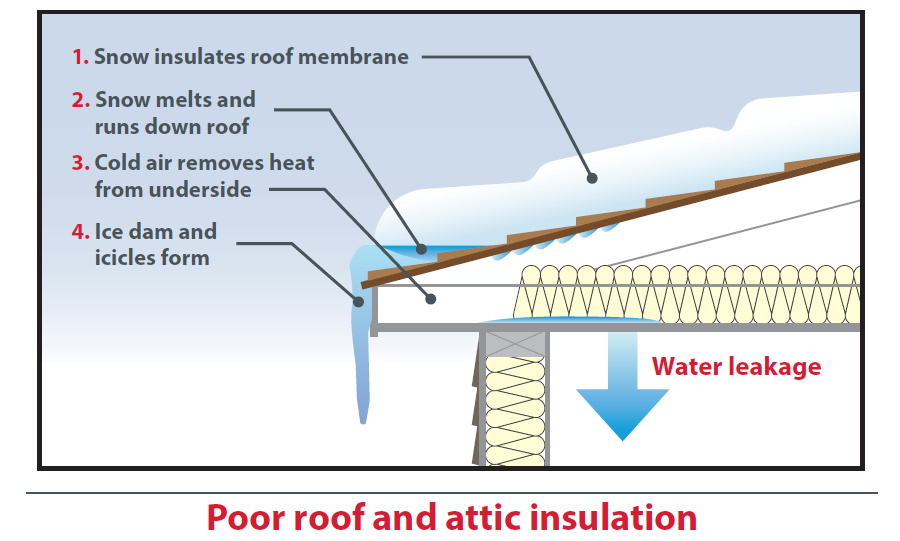Climate ready measures: Insulation
Thermal insulation is usually found in exterior walls (including basement walls) and attics and is designed to prevent heat transfer from one area to another—like in and out of your home.
Properly insulating your home reduces both heating and cooling costs and improves comfort. Insulation can also reduce sound transmission and help to control noise.
R-Values
The R-value is a measure of how well a two-dimensional barrier, such as a wall, window, or ceiling, resists the conductive flow of heat. The higher the R-value of a material, the better it is at insulating; protecting you from extreme heat (and cold) and also reducing your energy bills.
The R-value depends on the type of material, its thickness and density. The National Building Code -Alberta Edition requires an R-value of R22 (RSI 3.08) for all above ground framed walls. Your choice of wall assembly and insulation is far more important in protecting from extreme heat (or cold) than is your siding choice.
Financial support programs
Types of Insulation
When increasing the insulation in your home, you can choose from many types and materials. The most appropriate insulator will depend on where you want to add insulation and the recommended R-values for Calgary.
You must install at least the minimum levels of thermal insulation according to the National Building Code – Alberta Edition, but you can and should exceed these values where it is both practical and economical.
| Type | Material | Where applicable | Advantages | Installed costs |
|---|---|---|---|---|
| Blanket batts and rolls |
|
|
|
$0.05-0.06 per sq ft to increase R-value by 1 unit, depending on facing and material |
| Foam board and rigid foam |
|
|
High insulating value for relatively little thickness. | $0.22-0.29 per sq ft to increase R-value by 1 unit, depending on facing and material |
| Loose fill and blown-in fill |
|
|
Good for adding insulation to existing finished areas, irregularly shaped areas, and around obstructions. |
$0.04-0.06 per sq ft to increase R-value by 1 unit using blown fiberglass, cellulose or mineral wool Natural wool can cost 3-5 times more |
| Sprayed foam and foamed-in-place |
|
|
Good for adding insulation to existing finished areas, irregularly shaped areas, and around obstructions. | $0.15 per sq ft to increase R-value by 1 unit (closed cell polyurethane foam) |
Descriptions of insulation types are from US Department of Energy web page – Types of Insulation; cost estimates are based on RSMeans Residential Cost Data 2020. This fact sheet from the Insulation Institute compares the main types of insulation materials
Exterior wall insulation
Exterior wall insulation
Exterior wall insulation
When replacing your siding, installing an additional layer of exterior wall insulation can:
- improve the thermal comfort of your home;
- reduce impacts of extreme heat; and
- reduce energy costs.
Exterior insulation is usually mineral stone wool or extruded polystyrene (XPS). Mineral wool is more effective for fire resistance. XPS is more effective for water resistant, but mineral wool will regain its insulation value once dried out.

Interior wall insulation
Interior wall insulation
Interior wall insulation
Interior wall insulation (between the studs in the wall) is the typical way most older homes are insulated. This is one of the main building components for maintaining occupant comfort.
- Mineral wool insulation is the most fire resistant, and spray foam insulation is the most water resistant, although mineral wool will regain its insulation value once it has dried out.
- Fibreglass batt or cellulose insulation can clump together or slump over time, which permanently reduces the insulation value unless replaced.
- In a new build situation, a homeowner should consider an exterior wall insulation option. [see exterior insulation].
National Building Code – Alberta Edition requires RSI 3.08 (R22) in the wall cavities and RSI 10.43 (R60) in ceilings below attics. You should do that and more to help keep your home comfortable, your energy bills low, and protect against extreme heat.

Roof/attic insulation
Roof/attic insulation
Roof / attic insulation
Because hot air rises to escape, roof insulation is one of the most important factors in protecting a home from extreme heat (and cold) and heavy snowfall. For drywall ceilings that are nailed directly to the joists, cellulose insulation can be installed in the attic. Additional fiberglass batt insulation can be added on top.
The attic of your roof must be well vented to allow for airflow to dry out any condensation, leakage or other moisture build-up. A poorly vented attic can cause major moisture and mould problems as well as a loss in the effectiveness of your insulation.
Icicles hanging off your roof and gutter could be a sign of poor roof and attic insulation.


